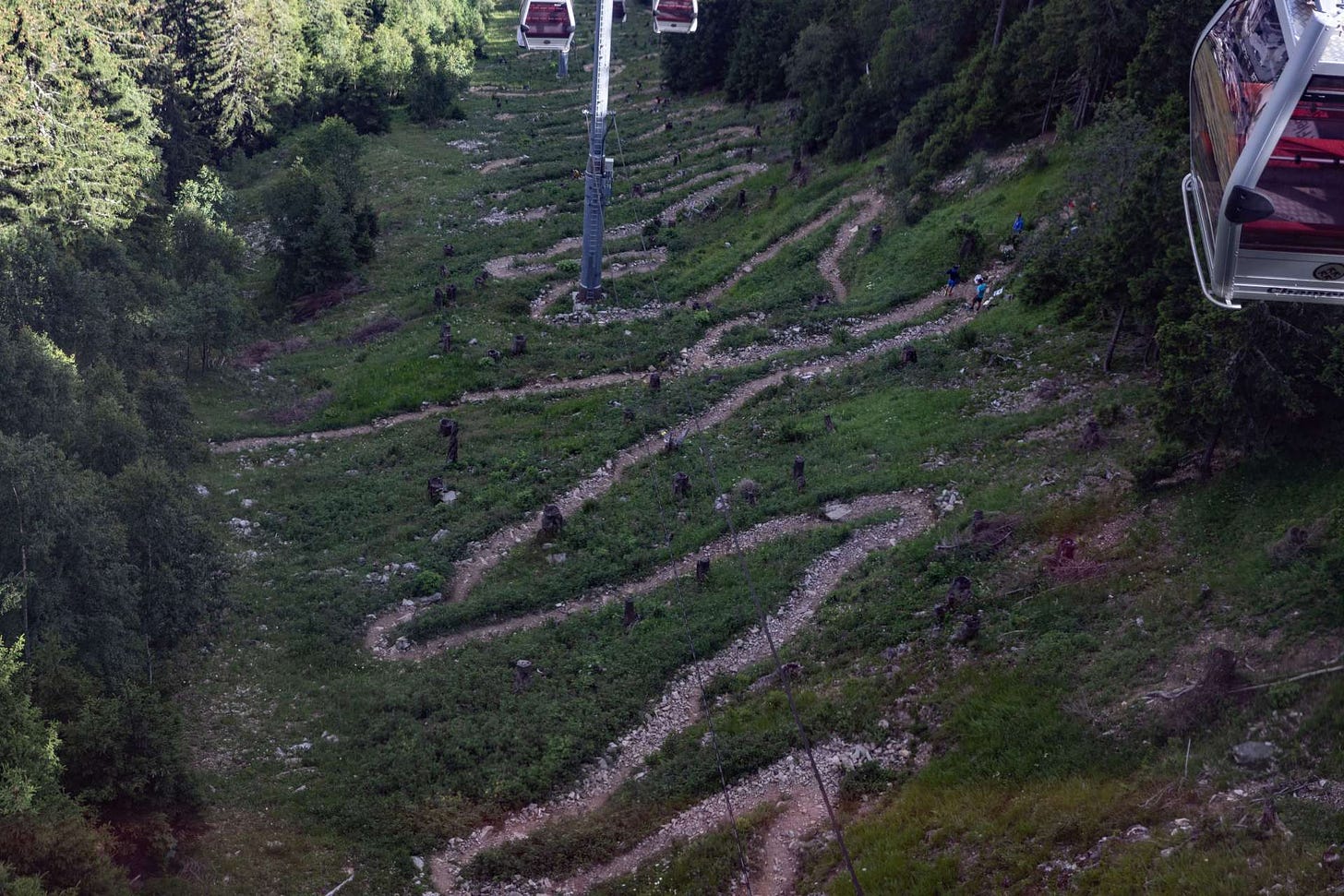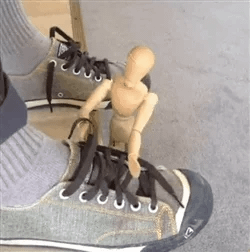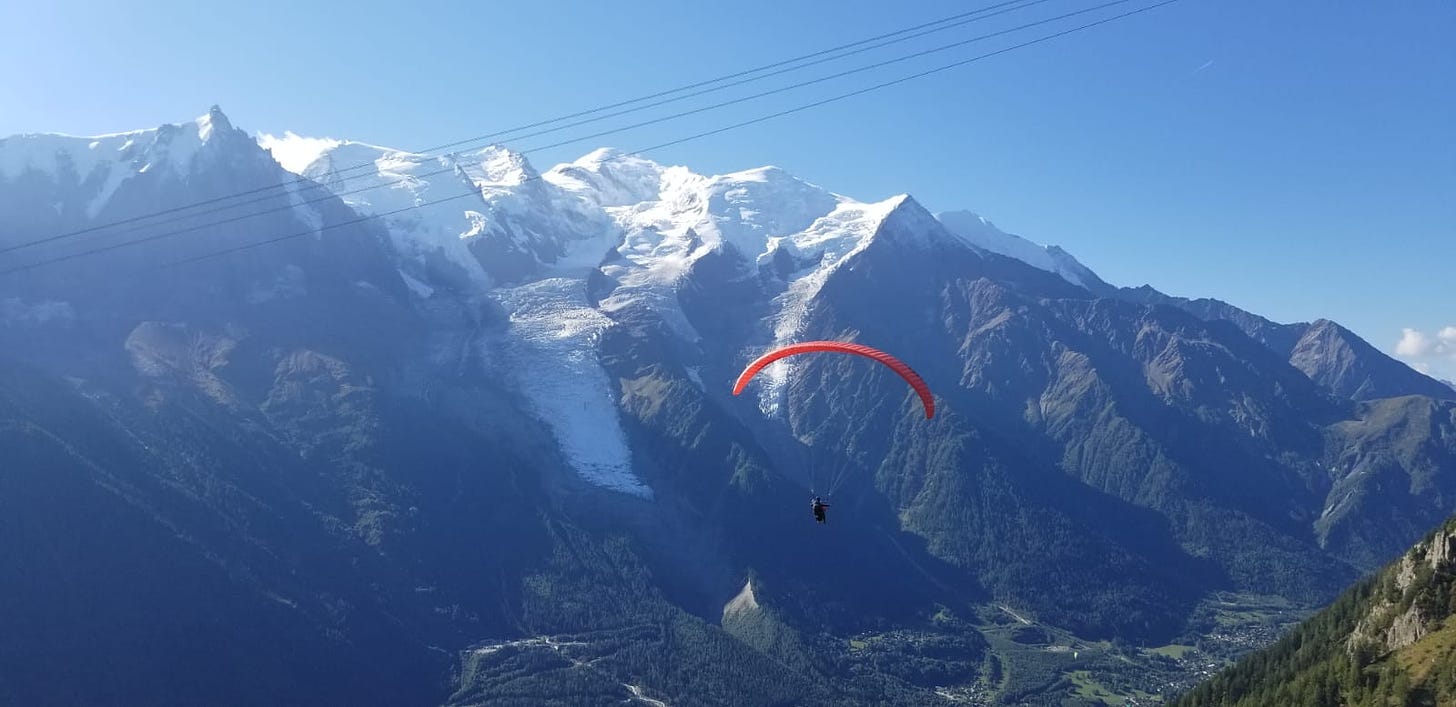High Adventure in Chamonix, Part I
An informational travelogue during which we discuss exercise-induced nausea as well as other forms of queasiness.
Note: I’m trying something different this week and next. This’ll be a two-part personal anecdote interspersed with the usual NPB nutrition intel. Please leave a comment to let me know what you think! (After reading it, of course.)
The Kilométre Vertical (Kmv) is a 3.8 kilometer (2.6 mile) trail that starts at Chamonix’s Paroisse Saint Bernard du Mont-Blanc and weaves up, up, up, under the path of a gondola lift. It ends at Planpraz-Brévent, an adventure hub overlooking the legendary Alpine French village that serves as a starting point for various hiking, skiing, and paragliding expeditions. If you have a vague grasp of the French language, you mayhave guessed that the trail features 1000 meters (3280 feet) of vertical ascent. It’s a butt kicker.
Fortunately, the La Bergerie de Planpraz at the top serves a decent espresso, so you have a little reward awaiting you should you choose to participate in the self-flagellation that is the Kmv.
I’ve done the Kmv twice—the most recent being a few weekends ago. Both times, I was visiting my in-laws, two retired mountain guides who, even in their seventies, are tougher than leather. My father-in-law, Elie, regularly goes on 100+ mile paragliding expeditions, hitchhiking home from wherever he lands. My mother-in-law, Nicole, spends much of her time foraging. It’s not unusual for her to vanish into the forest for a few hours and reemerge with four pounds of blackberries and several Smurf villages worth of porcini mushrooms.
I can do the Kmv faster than Nicole. This is not a brag. Rather, it is a plot point—because I suspect it bothers her a little. Putting things into context, the first time I did it—and thoroughly stomped my septuagenarian mother-in-law—my time was 1:03:08. The Strava record-holder is Scottish ultrarunner Jacob Adkin, who did it in 31:48. I’m nothing special.
That said, both times I’ve done it, it’s been the day after flying in from Redondo Beach, so I’m jetlagged and not acclimated to the altitude. (Chamonix sits in a valley at 3,396 feet above sea level) What’s more, the previous evening’s reunion meal inevitably involved cheese and wine, neither of which fuel me well for athletic activity.
Training at altitude.
The detrimental impact of jetlag (lack of rest) and wine (excess alcohol) are obvious. The cheese problem steams from the fact that I have a mild lactose issue. But the altitude issue? Let’s discuss!
If you’ve ever traveled to a higher altitude and tried to work out, you may have noticed that it can be harder to breathe and, thus, harder to exercise. People often think this is due to the amount of oxygen in the air. In fact, it’s all about barometric pressure. The closer you are to sea level, the more barometric pressure helps push oxygen into your bloodstream. The higher you go, the less pressure there is, and the harder you work to get air.
The human body tends to adapt to altitude after a couple weeks. There are a number of nutritional considerations that help with this adjustment. Your body uses more resources at altitude, so increase carbs, protein, and hydration. Also, iron helps your blood transport O2, so focus on meat, fish, legumes, and/or leafy greens. Adding vitamin C to the mix helps better absorb that iron.
On my recent trip to Chamonix, a two-week acclimatization period was not on the table. The night we arrived, Nicole announced that we would do the Kmv at 8:30am the next day, pointy sharp.
Despite my laundry list of crippling excuses, she also insisted that I give her and my wife Marilyne a 30-minute head-start.
To kill time as they headed up the hill the following morning, I ordered an espresso and a croissant at a crowded boulangerie across the courtyard from the Paroisse. I figured it might inspire me, sitting amongst the highly-equipped adventurers as we all carbed-and-caffeinated in preparation for our assorted epic journeys.
Sadly, it didn’t make me feel epic at all. These folks were checking their ropes, putting on Gore-Tex layers, fiddling with paraglider packs. Meanwhile, I sat there in half tights and a long sleeve Smartwool t-shirt staring at my little paper cup of coffee. I felt sadly under-equipped—the rare American with less toys than the Europeans surrounding him. I had nothing to fiddle with. I hadn’t even brought a hydration pack.
Just to fit in, I untied and retied my shoelaces a few times. After 25 minutes, I ran out of knot variations and took off up the Kmv.
When exercise makes you barfy.
Maybe “took off” is an overstatement. Within a few hundred feet, I knew Jacob Adkin’s record was not in danger. The legs were there. The lungs were not. I slowed from a steady run to a lunging hike—and started feeling barfy.
There are four common things that cause an athlete to feel nauseous during a workout. The first is gastric emptying delay. This means that whatever is in your stomach refuses to travel down into your intestines. This typically happens during hard efforts since your autonomic nervous system (which handles all the bodily functions you don’t do consciously) is focused on other priorities.
On the other hand, easy efforts can improve gastric emptying, which is why post-Festivus walks help with digestion and the meat sweats.
The second issue is splanchnic ischaemia, which I couldn’t pronounce if my life depended on it, so please don’t ask. It’s best translated as “abdominal lack of blood.” When you exercise, your blood travels to the muscles and skin in your extremities. Blood flow to your gut restricts. This leaves the organs in your abdominal cavity high and dry, literally. When this happens, your tummy can’t do what it’s supposed to do.
Splanchnic ischaemia explains the side cramps we sometimes get when combining exercise with digestion. It also adds credence to your mom’s insistence that you not get back in the swimming pool for 30 minutes after lunch.
The third issue is dehydration. The body can’t function properly if it’s not lubed up.
The fourth—and this is rare—is hyponatremia, which is when you have way too much water and not enough sodium. People freak out about hyponatremia, but it generally only happens in extreme circumstances, like with improperly hydrated ultra-athletes and frat hazing gone wrong.
Anyway, back to the Kilométre Vertical.
In my opinion, exercise-induced nausea comes from a cocktail of these reasons. In this case, I’d say my biggest issue was gastric emptying delay. While croissants should be a big part of any trip to France, their nutrition breakdown isn’t as carby as you’d think. At 231 calories with 12g of fat and 5g of protein, that heavenly, crusty crescent probably hadn’t shifted much in the 20-odd minutes I’d just spent perfecting my loop-the-loop shoelace knot.
Fortunately, I make a point of gut training by occasionally eating too much before hard efforts. I overcame the queasiness until about a third of the way up when the sun crested over Mont Blanc on the other side of the valley. I immediately started dumping sweat and regretting wearing wool, no matter how “smart” it was. I also regretted not bringing water.
A fresh wave of nausea took hold, this time from dehydration.
About two thirds of the way up, I spotted Nicole.
I caught Nicole, but my victory was short-lived. Marilyne was nowhere to be seen. She’d broken away from her mom. This would not do. Competition is the glue of our relationship. While I didn’t need to beat her to maintain harmony, it went without saying that I needed to die trying. I fought down the nausea and pressed on.
Adding a good bonk into the mix.
The last quarter of the Kilométre Vertical is a low-level via ferrata, meaning you climb/scramble up rock faces using installed metal footholds, ladders, and cables that make it marginally easier—although you’re not roped in and falling would still suck.
Sadly, at this point, all the footholds in the world weren’t going to help me unless they’d been mechanized and functioned as escalators. Adding to my misery, I started bonking, meaning I had run out of blood sugar and glycogen. I plodded my way to the top, my trail shoes now made of lead, where Marilyne waited for me. She’d arrived 15 minutes before me. Technically, I won since 25 minus 15 equals 10 minutes faster, but it’s not the same as catching her mid-effort.
We took a seat on the patio outside the bergerie. Despite a complete lack of desire to eat or drink, I lamely offered to go inside and buy us a couple of cafés allongés. Marilyne demurred, insisting I drink the water and eat the dried mangos she had the foresight to pack up. The very sight of them made me want to barf all the more.
The reason we’re sometimes not hungry after intense efforts—even when dehydrated and bonking—is tied into the same reason gastric emptying falters. Our body doesn’t know we actually wanted to suffer and that we’re safe. The autonomic nervous system shuts down the parasympathetic (rest and digest) nervous system and cranks up the sympathetic (fight or flight) nervous system to help us deal with what it perceives at the dangerous situation at hand.
Getting more specific, earlier this year, a study in the journal Nature identified the metabolite that causes this post-exercise appetite suppression. It’s called N-lactoyl-phenylalanine, or Lac-Phe, and scientists are now looking at ways to use it as a weight loss tool.
(For the record, according to Strava, I’d just burned through 903 calories and beat my old Kmv record by three minutes, so weight loss was not a priority.)
Son-in-law or beast of burden?
Nicole joined us a few minutes later. She informed me that Elie had ridden the gondola up with his paragliding equipment and wanted me to slog the 50-pound pack up the steep 1000-foot slope to the launch point. Clearly, this was payback for beating her up the Kmv again.
I made it to the launch point and dropped the pack on the grass. I wanted to be tired, crabby, and cold in my sweat-soaked running gear, but the view made it tough. Dozens of paragliders circled above me. The little town sparkled in the sunshine below and Mont Blanc loomed across the valley.
I thought about how I wanted to try paragliding someday. Maybe not in the dehydrated, jetlagged, hypoglycemic, non-altitude-acclimatized state I was in at the moment, but soon.
As I watched the next paraglider in line straighten out his sail on the grass and untangle his lines, Marilyne, Nicole, and Elie arrived. I asked Elie where he wanted his pack. He responded in French that it was up to me since it was my pack too.
I looked at Marilyne to translate with my “I understand all the words but I have no idea what he’s talking about” face. She laughed, pulled the bag open, and handed me a warm change of clothes.
The preparing paraglider marched up and extended his hand. “Hello. My name is Dominque. I’ll be your instructor this morning,” he said. Nicole and Elie had hired him to take me up in the air.
Nicole looked at me, joyfully beaming with brightness that surpassed the sunshine glittering off the windows below. There was no payback. She just wanted a special day for her son-in-law. As a mountain guide who’d spent a lifetime in the Alps, the only way she knew how to do that was to kick my butt.
So, today, I would be paragliding—and bringing my nausea to a whole new level.








What an epic tale Denis!! I loved reading this. The mix of scientific explanations for your own experience was fantastic!! Such great work! Can’t wait to catch up soon.
Denis, what a great story and clear explanation of nausea/exertion at altitude. Helped me understand my loss of appetite during the (6-day) Ride the Rockies - before riding, while riding and after riding for the day. Enjoy the rest of your holiday.